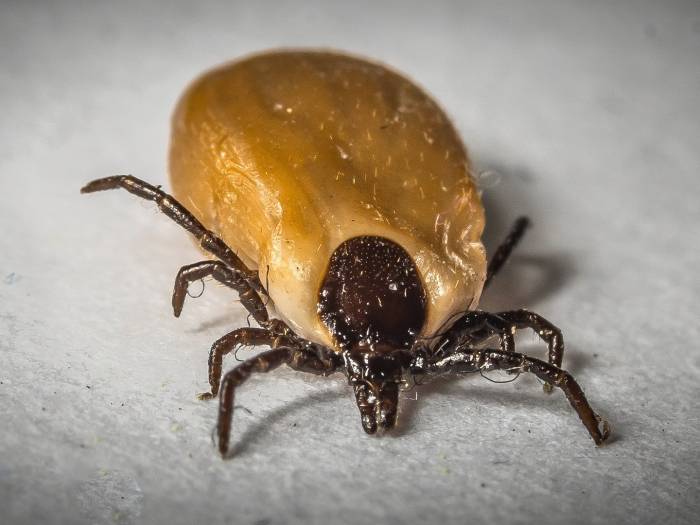Ticks are blood-sucking ectoparasites. Their hosts include all animals (including humans) and their numbers and geographical spread in the UK is increasing. This is likely to be due to a number of factors including a warmer climate, environmental schemes increasing tick habitats, and sheep being dipped less frequently.
There are more than 20 species of ticks but the most common sheep tick (Ixodes ricinus) can transmit louping ill, tickborne fever and tick pyaemia. All ticks can also transmit Lyme disease (caused by Borrelia burgdorferi) to humans, dogs and horses. Hill flocks are generally most at risk because ticks favour the dense vegetation and warm, humid conditions found in the uplands. However, ticks are also often found on lower lying areas of rougher grazing, field boundaries etc. Generally there are two peaks of tick activity, in the spring and in the late summer/autumn.
Lifecycle
Ixodes ricinus
is a ‘three-host’ tick with larvae, nymphs and adults feeding on different hosts. Larvae and nymphs prefers small to medium-sized animals and adults tend to feed on larger animals, such as sheep. This species of tick feeds on a broad range of mammals, birds, reptiles and is of growing concern with regard to it biting humans.
Diseases spread by ticks
- Louping ill. This is a viral disease that attacks the central nervous system and is the most common and economically serious disease risk for sheep, causing death in animals that are naïve or unvaccinated. Affected sheep will initially develop a fever and lack appetite. Muscular trembling, unsteadiness, seizure and paralysis may then develop with death occurring in 5-60% of cases. In areas where louping ill is endemic, the mortality rate is 5-10%. Young lambs acquire passive protection in colostrum, but as this wanes they become susceptible. Vaccination can play a role in protecting lambs and boosting colostral antibodies in ewes.
- Tickborne fever. This is caused by the bacteria Anaplasma phagocytophilum and suppresses the immune system of naïve animals. Infected individuals will have a sustained high temperature, anorexia and depression and, because of a supressed immune system, are susceptible to other diseases (such as louping ill and tick pyaemia). Naïve in-lamb ewes are likely to abort and may develop severe metritis (inflammation of the uterus) if untreated and naïve rams may become infertile.
- Tick pyaemia: Young lambs (up to 12 weeks old) can be affected by tick pyaemia, which causes abscesses in the tendons, joints, muscles and brain and causes ‘crippled lambs’ with severe lameness, paralysis of the backend, ill thrift and death. Up to 30% of the lambs in a group can be affected and there is no treatment.
Control
Apart from louping ill, where vaccination can play a role, the main way to control diseases transmitted by ticks is to treat at risk sheep with an acaricide treatment. The blowfly option table at the bottom of this page includes a column for ticks. Farms at risk of ticks need a plan that is specific to their situation, including the choice and timing of control products, so ask your vet or animal health advisor for advice. Always read the manufacturer's instructions before using a control product. Withdrawal periods are subject to change and it is the user’s responsibility to ensure withdrawal period is adhered to.
Particular care is required when new sheep are brought onto a farm with tick areas from a farm or area that is tick-free. Even adult sheep are at risk in these circumstances so they must be introduced well ahead of the breeding season and protected from ticks using an acaricide product.
Other considerations
- While some tick species do not transmit disease in sheep, given the increase in tick-related problems and their spread in recent years, farmers are encouraged to be aware of their tick situation and react if anything unusual happens.
- It is sensible to be aware of the symptoms of Lyme disease in humans, as it is seriously debilitating if not caught and treated early. The earliest and most common symptom is a circular ‘bullseye’ rash (see picture) that develops three to 30 days after an infected tick bite. However, a rash is not always seen so also look out for flu-like symptoms and tell your GP you may have been exposed. It is advised to cover exposed skin when in tick habitat, to check yourself afterwards and remove any ticks you find.
